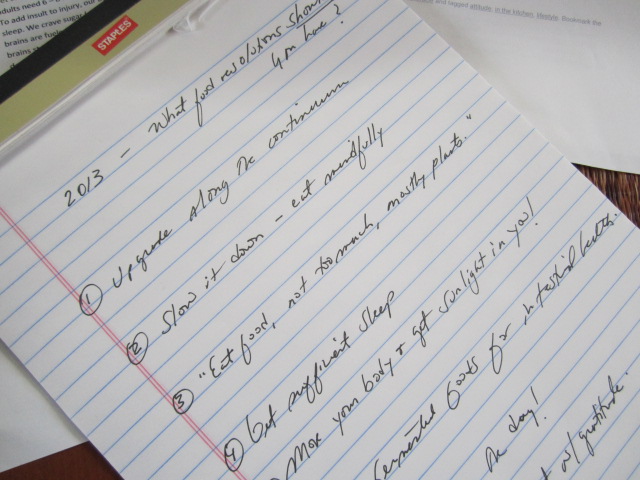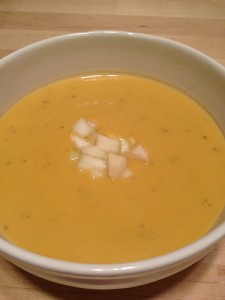It’s a new year, and with that often comes… the food and lifestyle resolutions. Well, it’s fifteen days into 2013 and I’m wondering if you are haunted yet by the words “I should…”? Research tells us that creating a new habit takes 21 days to congeal, so perhaps this article comes while you’re still in that grey zone of possibility – before your resolve begins to wither by the wayside.
 No, I’m not trying to be Debbie Downer here, but my life coach training taught me to regard the power of vocabulary, to listen for the energy behind the words of what one is saying. It’s a useful skill that reveals inner blocks and self sabotage with surprising acumen. For instance, if you find the word should is haunting your thoughts, know that whatever your resolutions are, it will involve struggle.
No, I’m not trying to be Debbie Downer here, but my life coach training taught me to regard the power of vocabulary, to listen for the energy behind the words of what one is saying. It’s a useful skill that reveals inner blocks and self sabotage with surprising acumen. For instance, if you find the word should is haunting your thoughts, know that whatever your resolutions are, it will involve struggle.
“Should” is a halfway word, the kind of motivator filled with conflict and guilt, not free-flowing from energized intention or ease, let alone anything resembling joy. That’s because “should” often infers someone else’s voice within us – dictating a strongly held belief that may or may not be relevant to our own current truth.
So I’ve decided to compile a short list of my top food and health tips for 2013’s winter season. Regardless of whether your food and lifestyle relationship is “should-ridden” or easeful, they will help you take care of yourself in ways that are effective and kind. They can also help to dissolve the shadow that “shoulds” may cast upon your goals.
With all the talk about the worst flu season ahead, pertussis on the rise, and who knows what kind of weather that might be in store for us, I hope you find some good guidance with these simple tips. Here’s to a healthy winter for us all!
- Upgrade along the Continuum – the overarching principle offering grace and guidance for eating and living healthier states: To whatever degree possible, and as often as possible, make wiser choices along the continuum of health and wellness. What’s essential to begin with is the recognitionthat all healthful change, no matter how small, is worthy of applause and should not be underestimated or thought of as insignificant. Perfection is not sustainable and influences us to abandon our goals. For endless results of freedom and control upgrade along the continuum using quality, quantity, and frequency applied to your choices. (See Wisdom to Eat and Live By for more details.)
. -

The Mindful Raisin Slow it down – eat mindfully. Perhaps you’ve read about the smart fork that beeps on your behalf when it senses that you’re eating too quickly – thereby aiding us to not overeat? Thanks to technology we can rely on external queues to alert us for just about everything – including if we’re shoveling our food. OR – you can learn to eat mindfully on your own, starting by simply taking 3 breaths before you begin to eat, noticing what is on your plate, where it came from, and how you are feeling before you eat it. (You might even ask yourself, “How hungry am I?”) Mindful eating provides a way to reconnect to your body, your food, and to the natural and healthy pleasure of eating. It just takes a little practice to internalize it. (See Mindful Eating for more details.)
. - “Eat food, not too much, mostly plants.” I cannot get past the encapsulated brilliance of these 7 words, and while I’ve eaten this way for years – I only wish I had written them. Thank you again, Michael Pollan for this wisdom. (Mindful eating is essential for the “not too much” part of the equation!) Whether you’re an omnivore, flexitarian or vegetarian, most of us would be better off embracing more plants (I’m talking real foods – not packaged/processed): organic greens and vegetables, seeds and nuts, and legumes, which are rich in fiber and nutrient dense. (I recommend In Defense of Food: An Eater’s Manifesto, Michael Pollan.)
. - Get sufficient sleep! This one is scientifically proven. Without sufficient sleep (most adults need 6 – 8 hours a night – consistently) ALL of our resources are compromised. To add insult to injury, our ability to digest carbohydrates is compromised with insufficient sleep. We crave sugar (simple carbohydrates) when we’re under-slept because our brains are fueled by glucose (blood sugar); therefore, when we are in need of sleep our brains start searching for carbohydrates to keep us going. If we’re chronically sleep deprived, we will grab cereals and cookies as our late night fuel, which will virtually guarantee unwanted weight gain!
. -

Dance in the sunlight! Move your body and get sunlight in you! We need to move our bodies for health and happiness. We’re animals, not plants! ALL movement counts, and the more integrated within our daily lifestyle, the better: going up and down stairs, walking the hallways and parking lots of our office building, parking farther away at the mall or grocery store, doing errands in town on foot on Saturday, shoveling our own walkways and driveways, as well as going to the gym or exercise classes, and let’s not forget – simply walking outside!
.
If you can do this on your lunch hour – especially in the winter when sunlight is low – please do yourself a favor and get outside. While some foods are fortified with Vitamin D, exposure to natural sunlight is an important source of Vitamin D. In winter we may suffer from depression (SAD- seasonal affective disorder) as a result of insufficient exposure to natural sunlight. (For more info: http://articles.mercola.com/sites/articles/archive/2004/04/03/vitamin-d-grant.aspx.)
. - Eat fermented foods for intestinal health. There is much talk about the importance of intestinal (“gut”) health these days, and its support of our immune system. I think this has come to the fore because of the rise in ingested antibiotics, whether they be from eating animals fed antibiotic-enriched diets, or from prescription antibiotics (including the increase in usage to combat food poisoning). Fermented dairy foods such organic yogurt and kefir, as well as jarred sauerkraut and kimchi (Korean fermented cabbage and radishes) are probiotic foods that replenish our intestines with necessary healthy flora.
.
A little bit of kimchi (1/4 cup) several times a week is helpful. Try kimchi as a condiment with lunch, on sandwiches, rice, with eggs or beans. Fermented enzyme-rich miso paste (an Asian seasoning made from soybeans – buy organic/non-GMO only – barley, brown rice and other grains) is a healthy probiotic food as well. Also you can try Braggs Liquid Amino Acids: an awful name for a great naturally fermented product I’ve used for 27 years. It’s certified non-GMO and vegetarian, like a tamari sauce but much lighter. I use it with olive oil sprinkled on steamed vegetables, in soups, and for general flavor in brown lentils and other foods.
. -

Squash and pear soup Soup saves the day! I just had to include this, after all, it’s winter, and what’s better than a warming bowl of hearty soup? It’s a mileage food – you get back several meals in return for your efforts. Make it, freeze some, have it on hand for delicious week night dinners. Soups can be great additions to meals or nearly stand alone dinners. Also, filling up with homemade soup is an enjoyable and effective way to help lose weight. (Check out some of my soup recipes here.)
. - Cook with love, eat with gratitude. When we eat homemade real food it takes some time to prepare it (compared to popping a frozen dinner in the microwave). I consider this an act of self-love. Whether we are cooking for ourselves or others, adding the gift of loving thoughts is a transformative ingredient not to overlook, as negative intention or resentment added to any meal can be as toxic as any unhealthy food choice. Gratitude for the good food we eat, the land, animals, farmers, person who prepared it, our own body that is consuming it as fuel; all is worth acknowledging with appreciation when we eat.
Until next time,
Ina
________________________________________
Photo credits:
Dance in the sunlight, Gexydaf
Raisins, Dottie Mae
Butternut squash and pear soup, Crystal Calderon
Used with permission under Creative Commons license.
